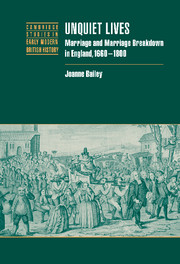Book contents
- Frontmatter
- Contents
- Acknowledgements
- List of abbreviations and conventions
- 1 Introduction: reassessing marriage
- 2 ‘To have and to hold’: analysing married life
- 3 ‘For better, for worse’: resolving marital difficulties
- 4 ‘An honourable estate’: marital roles in the household
- 5 ‘With all my worldly goods I thee endow’: spouses' contributions and possessions within marriage
- 6 ‘Wilt thou obey him, and serve him’: the marital power balance
- 7 ‘Forsaking all other’: marital chastity
- 8 ‘Till death us do part’: life after a failed marriage
- 9 ‘Mutual society, help and comfort’: conclusion
- Appendices
- Bibliography
- Index
- Titles in the series
2 - ‘To have and to hold’: analysing married life
Published online by Cambridge University Press: 27 July 2009
- Frontmatter
- Contents
- Acknowledgements
- List of abbreviations and conventions
- 1 Introduction: reassessing marriage
- 2 ‘To have and to hold’: analysing married life
- 3 ‘For better, for worse’: resolving marital difficulties
- 4 ‘An honourable estate’: marital roles in the household
- 5 ‘With all my worldly goods I thee endow’: spouses' contributions and possessions within marriage
- 6 ‘Wilt thou obey him, and serve him’: the marital power balance
- 7 ‘Forsaking all other’: marital chastity
- 8 ‘Till death us do part’: life after a failed marriage
- 9 ‘Mutual society, help and comfort’: conclusion
- Appendices
- Bibliography
- Index
- Titles in the series
Summary
SOCIAL, ECONOMIC AND GENDER DIVERSITY
In order to reappraise marriage in the seventeenth and eighteenth centuries, it is vital to use sources that include a wide range of social and occupational groups and reflect both sexes. Correspondence, memoirs and autobiographies are rewarding sources for the study of married life, but they only provide an insight into elite marriage. The best way to investigate the marital behaviour of the middling sort and wage labourers is to analyse evidence from matrimonial conflict. This study examines matrimonial and correction suits, for which cause papers survive, that came before Durham, York and Oxford ecclesiastical courts. As well as dealing with the administration of the Church, these courts maintained the spiritual discipline of the clergy and their parishioners. Court business involving the laity was conducted in two ways. In disciplinary cases (office cases), church courts brought people before them to be corrected for a range of offences, of which immorality is of interest here. Secondly, people sued each other (instance cases), and this study examines litigation concerning marriage. Church courts offered a range of solutions to people suffering from marital difficulties, including: annulment, where specified impediments dissolved marriage, allowing spouses to remarry; separation from bed and board on the grounds of adultery and cruelty, which permitted couples to live apart but not remarry; and restitution of conjugal rights, ostensibly a way to force a spouse to return or to accept the other back into the marital home, but commonly used to settle problems about financial maintenance.
- Type
- Chapter
- Information
- Unquiet LivesMarriage and Marriage Breakdown in England, 1660–1800, pp. 12 - 29Publisher: Cambridge University PressPrint publication year: 2003



